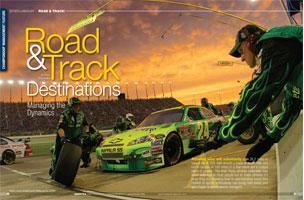
Athletes who will voluntarily run 26.2 miles or race a car at 200 mph around a track or swim, bike and run in excess of one hundred miles in a few hours are a unique blend of people. The feats these athletes undertake may seem ludicrous to most people but to these athletes it's what they do. Knowing how to appropriately serve this market of sports enthusiasts can bring new levels and advantages to sports events managers.
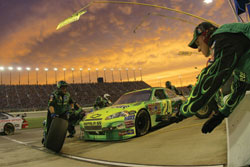 Road and Track sports include various types of automobile and motorcycle racing. Additionally, there are several categories of bicycle racing as well as triathlons, Ironman competitions, and marathons. These events range from high-speed car races to races that rely simply on human strength and stamina. They are unique in that on one end of the spectrum some races can only be held in a handful of cities because they require a motor speedway. On the other end is the fact that road events can be held in almost any city that is willing to devote time and energy to developing a race. Both of these markets can be served by focusing on space, safety and community relations.
Road and Track sports include various types of automobile and motorcycle racing. Additionally, there are several categories of bicycle racing as well as triathlons, Ironman competitions, and marathons. These events range from high-speed car races to races that rely simply on human strength and stamina. They are unique in that on one end of the spectrum some races can only be held in a handful of cities because they require a motor speedway. On the other end is the fact that road events can be held in almost any city that is willing to devote time and energy to developing a race. Both of these markets can be served by focusing on space, safety and community relations.
NASCAR racing is an extremely popular sport even though some don't consider it a sport at all. However, as Ben Benson of the Joliet CVB points out "Racing is definitely a sport, a high competition sport. Driving in general, amateurs and pros, becomes competitive." Even though there are few athletes competing professionally, the number of people attending race weekends is approximately 100,000. Bob Welch of the Chicagoland Speedway in Joliet, Illinois, notes "The speedway holds 75,000 people inside but there can be anywhere between 10 and 15 thousand outside."
Because many of the elements of an actual race are taken care of by NASCAR and the other racing governing bodies like IRL and ARCA, track owners and CVB staff turn their focus to the fans and community at large. A large influx of people flooding into a town has a huge impact and Welch and Benson are quick to note the benefits and challenges. Benson says, "Our mission is to enhance the experience of anyone coming to Joliet. The average person spends $116 a day, they're here for 2.5 days. Multiply that times thousands of people and it adds up to millions in the economy." Benson goes on to say, "The economic impact trickles down to hotels, gas stations, professional services and camp grounds." Welch adds, "Chicago has typically been a stick and ball town, but now we're giving them another option. Lots of people enjoy racing so Chicagoland has started developing a convention that can draw thousands of fans. We want to make it an entire weekend,a party event that will take place just before the NASCAR season."
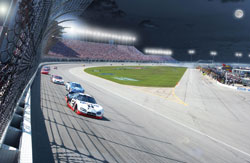 Don Cohen of the Bakersfield CVB also recognizes the opportunities his city offers as well as the economic impact on the city. "We're one of the unique venues that have a dirt track, a formula track and a drag strip. We offer a great value to anyone coming to town because if someone is doing an event in Bakersfield people can afford to find a nice, inexpensive room. And our races draw people from all over the world,which typically means four to five thousand hotel rooms booked."
Don Cohen of the Bakersfield CVB also recognizes the opportunities his city offers as well as the economic impact on the city. "We're one of the unique venues that have a dirt track, a formula track and a drag strip. We offer a great value to anyone coming to town because if someone is doing an event in Bakersfield people can afford to find a nice, inexpensive room. And our races draw people from all over the world,which typically means four to five thousand hotel rooms booked."
While the benefits of hosting a race are extensive, there are a number of challenges that must be met to ensure people come back. To make each racing experience a positive one there must be a tremendous amount of planning and coordination. Cohen says, "First of all, speak with people who know the event best, those putting it on, and get an understanding of the dynamics of the event. If you're going to work with any type of event that isn't necessarily your forte, rely on the experts."
Not only does the staff of the speedway have to communicate effectively internally, they must also coordinate with numerous outside agencies. Welch notes moving the Chicagoland NASCAR race from day to night posed additional challenges. Now that the race goes late into the night, "it can end up taking two to three hours to get home or onto a highway after the race is over." This switch in timing required greater communication with and support from the area police officials to ensure everyone made it home as quickly and safely as possible.
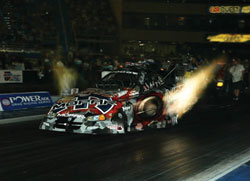 While the economic impact is significant, CVB and track staffs have to promote the available amenities to feel the impact. Also, while NASCAR races require little to no major promotion, less "popular" races will need additional promotional support to draw people to the city and fill seats. Benson points out "We do cross community marketing to reach the visitors. There aren't a lot of services around the track, so people have to come to town for services. We promote the experience of visiting Joliet, the local favor, by placing advertising in the ticket holder's booklets."
While the economic impact is significant, CVB and track staffs have to promote the available amenities to feel the impact. Also, while NASCAR races require little to no major promotion, less "popular" races will need additional promotional support to draw people to the city and fill seats. Benson points out "We do cross community marketing to reach the visitors. There aren't a lot of services around the track, so people have to come to town for services. We promote the experience of visiting Joliet, the local favor, by placing advertising in the ticket holder's booklets."
Cohen adds, "Events can fall flat if there isn't any promotion. It can be the greatest event ever, but if nobody knows then it won't be. I have someone on my staff who is really good with media relations and has a radio and advertising background. This is something not all CVBs have the luxury of having but it would be worth spending the money to contract with someone for an event and to offer that to somebody."
Remembering that racing fans are loyal and will travel as a family is key to success in this market. As Welch points out, "Racing is a community. People may see each other only once a year but they will always set up their camps next to each other." In fact, racing has become so popular that it is slowly moving from a spectator sport to now including opportunities for race fans to hit the track themselves. The Autobahn Country Club offers racing enthusiasts the opportunity to race their own cars at the facility. Mark Basso, owner, says, "Autobahn is a unique facility. The track is challenging, exciting and physical. It's a unique experience because the track conditions are always different. Everyone can golf but to drive a road course at these speeds is something that not everyone can do and nobody else can offer." Addressing the importance of offering services for families of race fans, Basso is currently adding a hotel. "We're making it more accessible; we make it easy to join the club, bring the family, and we're allowing the sport to become more mainstream."
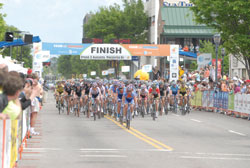 Even though Road events fall under the same umbrella as Track events, they are quite different in scale and scope. Track events keep the action confined to one primary area. A Road event, however, is anything but contained. These races require greater amounts of space because the nature of the sports is such that they cover significant distances. Additionally, these athletes bring their own equipment and as Randy DuTeau of the Augusta Sports Commission says, the role of the CVBs and event organizers is to make it so that "they can basically come plug in and play." He goes on to say, "First and foremost is planning - give yourself a lot of time and don't try to be the expert. Ask questions. We have a lot of sweat equity in our events; they've got our name on them so there is an expectation that we're going to live up to our end of the bargain."
Even though Road events fall under the same umbrella as Track events, they are quite different in scale and scope. Track events keep the action confined to one primary area. A Road event, however, is anything but contained. These races require greater amounts of space because the nature of the sports is such that they cover significant distances. Additionally, these athletes bring their own equipment and as Randy DuTeau of the Augusta Sports Commission says, the role of the CVBs and event organizers is to make it so that "they can basically come plug in and play." He goes on to say, "First and foremost is planning - give yourself a lot of time and don't try to be the expert. Ask questions. We have a lot of sweat equity in our events; they've got our name on them so there is an expectation that we're going to live up to our end of the bargain."
Adding to DuTeau's comments, Sue Harshbarger of the Convention & Visitors Association of Lane County, Oregon, says, "Cycling is a social activity so organizers need to have a hospitality room and a local watering hole. Also, riders come with their own equipment so there has to be a place to get that stuff organized. There have to be food stations and if a water station isn't where the riders were told it would be it is a problem. Also finding a hotel close to the start/finish line is critical because they will likely just ride their bike to the locale."
A successful Road event requires a strong dedication to safety and permitting. Because participants are exposed to traffic and other hazards, event planners and hosts must take appropriate steps to prevent accidents and injuries. Before any race can take place on a public road, permits must be obtained from the local authorities and city officials. Harshbarger encourages organizers to "get it going early because permit acquisition takes time and the events take money. Each event brings a different permit trial. Safety is always paramount so organizers have to build relations with county permitters and we help get the permit process started." The permitting process must also include communication with the local police and DOT to ensure that all traffic issues are addressed in advance of the event.
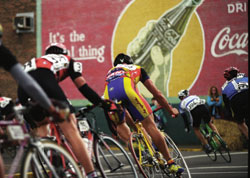 Each race will have multiple participants but they will not all be handling the course at the same speed. As DuTeau points out, "In Running events you have a range of abilities, the guy who wins in an hour and fifteen minutes and then the person who finishes in three hours. It's a larger window and you're talking about people completely exposed and a specific speed level which cyclists don't have so there is greater potential for things not working out so you have to make the plan much tighter."
Each race will have multiple participants but they will not all be handling the course at the same speed. As DuTeau points out, "In Running events you have a range of abilities, the guy who wins in an hour and fifteen minutes and then the person who finishes in three hours. It's a larger window and you're talking about people completely exposed and a specific speed level which cyclists don't have so there is greater potential for things not working out so you have to make the plan much tighter."
With so many athletes covering a road course at various degrees of speed, the potential for community disruption is heightened and the impact of a road race on the community must be considered. Harshbarger advises, "Keep in mind who is impacted and for how long -do some forewarning and put the word out in advance and post lots of signs." DuTeau agrees. "There is no way we could make the events happen without community partnerships." He also cautions, "You have to create as little impact on the community at large. Keep things flowing, don't be intrusive and never be arrogant with the community."
Road events are not quite as spectator driven as Track events but there is an aspect of the sport that is geared toward the spectators. Mike Murray of the Oregon Bicycle Racing Association says, "Track racing is different because you have limited participants. The focus is trying to put people in the stands. Track racing happens in front of you so we try to do flashier events."
Track cycling events also have the advantage, as Murray points out, of being easier to host. "People interested in sponsoring a cycling event should start with something smaller. Putting on a track race is the simplest thing to do because equipment is there and this way you don't have to worry about volunteers or road issues."
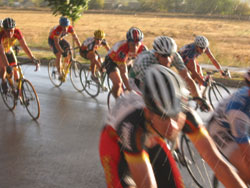 Road events draw a host of fans to a city. As DuTeau points out, "The Ironman brings 2,500 people. The economic impact is staggering and it is great for hotels, restaurants and the community." Harshbarger offers a slightly different take from the cyclist's perspective. "Cyclists are a unique blend of people. They come to our city and they're exploring it on a bike, not using resources, but they are getting an up close and personal experience which means they're more apt to come back."
Road events draw a host of fans to a city. As DuTeau points out, "The Ironman brings 2,500 people. The economic impact is staggering and it is great for hotels, restaurants and the community." Harshbarger offers a slightly different take from the cyclist's perspective. "Cyclists are a unique blend of people. They come to our city and they're exploring it on a bike, not using resources, but they are getting an up close and personal experience which means they're more apt to come back."
Road and Track races are about community. The fans and athletes that travel to Track races enjoy the camaraderie they experience during the hours of tailgating just as the cyclists, runners and swimmers enjoy participating in an event where they are included and welcomed as part of the city's community. A genuine approach to building this sense of community while providing appropriate resources and a safe environment can lead to a successful Road or Track event.
American Bicycle Association BMX
American Motorcyclist Association (AMA)
Association of International Marathons and Distance Races (AIMS)
Automobile Racing Club of America
Indy Racing League
International Olympic Committee
International Motor Sports Association
Ironman USA
National Association for Stock Car Auto Racing (NASCAR)
National Auto Sports Association
Oregon Bicycle Racing Organization
USA Cycling
USA Triathlon

